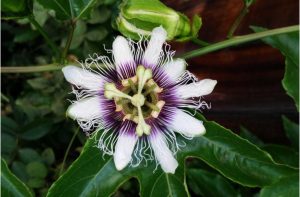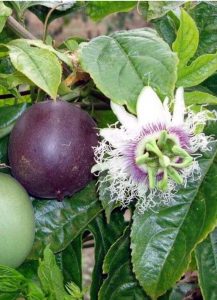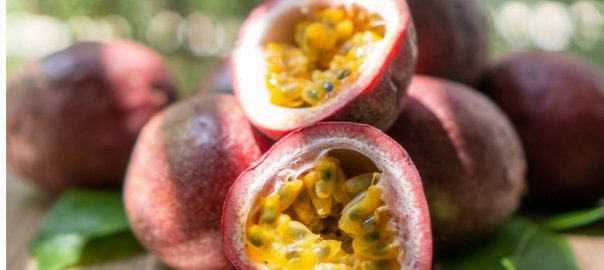Grow Me Now!
January
A Passion for Fruit!
You may have seen them, recently, hanging like gorgeous Christmas decorations from their vines. Passionfruit, which take 2 to 3 months to mature, are in the process of ripening in January, with the skins of pickable fruit turning a deep purple (or gold, depending on variety) from February through to June. While the vines are tropical, they can also be grown in frost prone regions when planted in an unheated tunnelhouse. Bear in mind, however, that although passionfruit vines will tolerate frosts of minus 1-2°C, more severe frosts (or even lighter frosts which continue for more than short periods), will kill off new growth. This poses problems for those growing in mountainous regions such as Central North Island and inland Otago. But, outside of areas that are prone to severe cold, not only will a tunnelhouse provide the warmth the vines crave, it will also offer the shelter needed for the plant to thrive.

Source
While mid-summer may seem an unlikely time to introduce a new perennial to your tunnelhouse, passionfruit can be planted at any stage from mid-spring to mid-summer (or even later if temperatures remain warm). The vines are readily available in nurseries and garden centres, but take care which variety you choose*, as some grow more vigorously than others and are less suited to undercover growing (yellow-fruiting passionfruit vines are particularly fast growing). Additionally, although passionfruit vines are self-fertile (both male and female flowers appear on the same plant), they will fruit better if planted in pairs. Additionally, some varieties are self-incompatible, and must have a partner plant in order to set fruit. Ask your nursery for advice.
Passionfruit vines survive for around 4-5 years, only, and have a long taproot, so be weary of accepting offers of a plant that needs to be uplifted from its in-ground growing position. Varieties grafted onto rootstock should never be uplifted as the disturbance can result in the development of unproductive suckers.
*Never plant banana passionfruit (Passiflora tripartita). It is illegal to grow this invasive species.
Ground work
Before you prepare the ground to receive your passionfruit vine, you will need to erect supports for this vigorous climber. The weight of the vine, combined with the weight of the fruit, means the supports need to be robust (poles dug into the ground, with number 8 wires or frames of builder’s reinforcing iron, between them, are ideal). Use the maximum height available to you but avoid extending the support across the roof of the tunnelhouse or you will lose valuable heat and light.
Passionfruit vines are hungry plants which require excellent drainage to thrive. Prepare the growing hole (which should be twice the width and depth of the container the plant is growing in) by digging out spent soil, and replacing it with rich compost, blood and bone, and seaweed. (If the ground below the hole is clayish, dig deeper, and add a 10 to 15cm layer of fine stones or river gravel before topping up with your growing mix. If you don’t have the wherewithal to provide organic ingredients, choose a suitable growing medium, such as that used for citrus fruits. A pH level of 4.5 (strongly acidic) soil will help with fruit production.

Transplanting
If you have space in your tunnelhouse for two plants, space them approximately 2 metres apart. Before transplanting, water the growing site well, and leave it for an hour, to drain. Plant in the cooler part of the day (early morning or evening) by first gently teasing out the roots from the root ball of the vine, taking care not to break them. Place the plant in the prepared hole, ensuring that the soil does not reach above the level it was when the vine was in its pot. Water again. Ensure the tunnelhouse is well ventilated.
Pollination will be aided by the movement of insects. To draw them into your tunnelhouse, grow flowering plants in the tunnelhouse as well as close to its doorway (growing flowering plants in pots means you can replace them, when their blooms are spent, with others that are coming onstream.
Maintenance
Passionfruit vines are vigorous growers, so they routinely use up nutrients from the soil. Replenish these by topping up the area around the vine with more mature compost and weekly feeds of organic liquid manure or a recommended fertilizer. Cut back on blood and bone as the vines gain height and begin flowering, as high nitrogen levels create foliage at the expense of fruit. At pre-flowering and flowering time, increase levels of potassium (seaweed water, for organic growers).
Keep a watch for sap-sucking insects such as aphids, and squash them with your fingers in the first instance. If the pests persist, apply a spray made from 1/4 tsp hard bathroom soap dissolved in half a litre of boiling water that has been left to cool completely. Repeat every 3-4 days. Note: if you are growing organically, there is no need to completely rid the plants of pests – a healthy balance is what you are aiming for because the general strength of the plants means they can hold their own against a degree of pest attack. Be sure to gather up fallen leaves to avoid providing hiding places for pest insects.
Keep the tunnelhouse well ventilated, day and night, and harvest fruit as soon as it is ripe to take the pressure off the plants.
When keeping vine growth under control, remember that fruiting will occur on new growth, so don’t snip this all off! Prune in spring, only after frosts have abated, so that you do not stimulate new tender growth that will be knocked back by sub-zero temperatures. Prune in autumn to retain the shape of your vine, and to allow air to circulate.
Tips
Always use snips to harvest, rather than pulling off the fruit, which can damage the vine.
In very frosty conditions, cover the vines with a layer (or two) of frost cloth for extra protection.
Spraying the vines with a seaweed tonic solution can help increase resistance to frost.
Stop feeding, and reduce watering over the coldest months to discourage new growth which could be cut back by frost.
The vines don’t like competition, so keep the ground beneath them weeded and mulched.
Once night time temperatures drop to below 19°C, flowers tend to drop off, and those that remain require insects to pollinate them.
